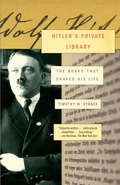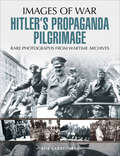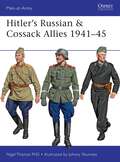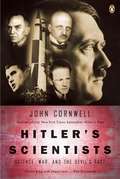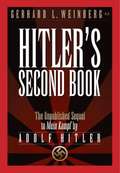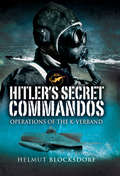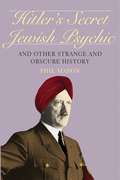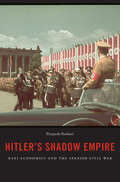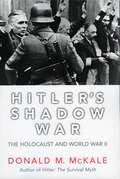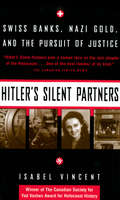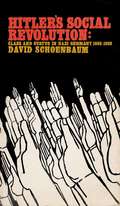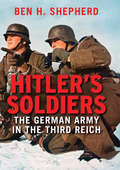- Table View
- List View
Hitler's Priests: Catholic Clergy and National Socialism
by Kevin SpicerShaken by military defeat and economic depression after War World I, Germans sought to restore their nationÆs dignity and power. In this context the National Socialist Party, with its promise of a revivified Germany, drew supporters. Among the most zealous were a number of Catholic clergymen known as \u201cbrown priests\u201d who volunteered as Nazi propagandists. In this insightful study, Spicer unearths a dark subchapter in Roman Catholic history, introduces the principal clergymen who participated in the Nazi movement, examines their motives, details their advocacy of National Socialism, and explores the consequences of their political activism. Some brown priests, particularly war veterans, advocated National Socialism because it appealed to their patriotic ardor. Others had less laudatory motives: disaffection with clerical life, conflicts with Church superiors, or ambition for personal power and fame. Whatever their individual motives, they employed their skills as orators, writers, and teachers to proclaim the message of Nazism. Especially during the early 1930s, when the Church forbade membership in the party, these clergymen strove to prove that Catholicism was compatible with National Socialism, thereby justifying their support of Nazi ideology. Father Dr. Philipp Haeuser, a scholar and pastor, went so far as to promote antisemitism while deifying Adolf Hitler. The F\u00fchrerÆs antisemitism, Spicer argues, did not deter clergymen such as Haeuser because, although the Church officially rejected the NazisÆ extreme racism, Catholic teachings tolerated hostility toward Jews by blaming them for ChristÆs crucifixion. While a handful of brown priests enjoyed the forbearance of their bishops, others endured reprimand or even dismissal; a few found new vocations with the Third Reich. After the fall of the Reich, the most visible brown priests faced trial for their part in the crimes of National Socialism, a movement they had once so earnestly supported. In addition to this intriguing history about clergymen trying to reconcile faith and politics, Spicer provides a master list—verified by extensive research in Church and government archives—of Catholic clergy who publicly supported National Socialism.
Hitler's Private Library: The Books That Shaped His Life
by Timothy W. RybackHe was, of course, a man better known for burning books than collecting them and yet by the time he died, aged 56, Adolf Hitler owned an estimated 16,000 volumes -- the works of historians, philosophers, poets, playwrights and novelists. A passionate reader, his worldview was largely formed by the books he read. For more than fifty years the remnants of Hitler's private library occupied shelf-space in climate-controlled obscurity in the rare book division of the Library of Congress in Washington. Timothy Ryback is the first to systematically explore this remarkable collection, as well as several other caches which he subsequently discovered in Europe and elsewhere. The volumes in Hitler's library are fascinating in themselves but it is the marginalia -- the comments, the exclamation marks, the questions and underlinings, even the dirty thumbprints on the pages of a book he read in the trenches of the First World War -- which are so revealing. Together they take us closer to the man and his thinking than ever seemed possible. Hitler's Private Library provides us with a remarkable view of Hitler's evolution u and unparalleled insights into his emotional and intellectual world. Utterly compelling, it is also a landmark in our understanding of the Third Reich.
Hitler's Propaganda Pilgrimage (Images of War)
by Bob CarruthersThe famous image of Hitler in Paris has become one of the most iconic images of the Second World War. However, Hitler only spent a few hours in Paris before heading to Flanders to re-visit the sites of the battlefields where he had served during the Great War. He was on a propaganda mission to publicize his own war service and a full photographic record of Hitler's visits to France and Flanders was produced by Heinrich Hoffman, Hitler's personal photographer. Those photographs from 1940 have now been collected together for the first time and are reproduced here along with all of the most important surviving images of Hitler in the Great War.Featuring rare and previously unpublished images of Hitler in France and Flanders from 1914 to 1940, this important photographic study documents a vital but often overlooked chapter in the story of Adolf Hitler.
Hitler's Raid to Save Mussolini: The Most Infamous Commando Operation of World War II
by Greg AnnussekSpringing Mussolini from the mountaintop hotel in which his king and country had imprisoned him was the easy part. Sorting out who did what and when is the tricky bit. Working from an array of primary sources, independent scholar Annussek sorts the self-serving statements from the outright lies to describe the nazi raid that sprung Mussolini, complete with its gliders, paratroopers, ranks of commandos blasting through what were in fact their ally's ranks, open bragging by the victors and, on the part of the general public, confusion about how and why Hitler decided Mussolini was safer on the loose than he was bricked up. Annussek describes how the war in Italy factored in the Berlin-Rome alliance, how saving Mussolini temporarily worked in terms of German morale, and how the very odd relationship between Hitler and Mussolini complicated the motives for the raid even more. Annotation ©2006 Book News, Inc. , Portland, OR (booknews. com)
Hitler's Religion: The Twisted Beliefs that Drove the Third Reich
by Richard WeikartFor a man whom history can never forget, Adolf Hitler remains a persistent mystery on one front-his religious faith. Atheists tend to insist Hitler was a devout Christian. Christians counter that he was an atheist. And still others suggest that he was a practicing member of the occult. <P><P>None of these theories are true, says historian Richard Weikart. Delving more deeply into the question of Hitler's religious faith than any researcher to date, Weikart reveals the startling and fascinating truth about the most hated man of the 20th century: Adolf Hitler was a pantheist who believed nature was God. <P><P>In Hitler's Religion, Weikart explains how the laws of nature became Hitler's only moral guide-how he became convinced he would serve God by annihilating supposedly "inferior" human beings and promoting the welfare and reproduction of the allegedly superior Aryans in accordance with racist forms of Darwinism prevalent at the time.
Hitler's Resurrection
by Steve MatthewsNazi Germany has been crushed, but is the war really over?Klara, Hitler&’s personal cook, swears she glimpsed him fleeing the Berlin bunker via a secret tunnel.The world needs undeniable proof of the Fuhrer&’s death, but it&’s not that simple. While Allied intelligence agents scour Europe to find such proof, and a Hitler double – &‘the Wolf&’ – lays a false trail across two continents, the real Hitler hides out in a Polish monastery, desperate to find his gold train so he can fund the Fourth Reich. Klara, already pregnant with Martin Bormann&’s child, is one of the countless women brutally raped as Russian forces take Berlin. She miscarries and can&’t help wondering if she will ever be free of the war&’s burden. Meanwhile, her sister Natalka is working with the Polish government, tracking down and executing Nazi fugitives. She locates Klara and recruits her to help track Hitler: as his former cook, Klara can infiltrate his inner circle. They find Hitler&’s hideout via a tip-off. Klara makes tentative contact: the Fuhrer, weakened and isolated, is thrilled to have her back as his cook – and companion. He feels no threat from her but – profoundly traumatised by the war, the death camps, the rape and miscarriage – Klara can take no more. Following a defining act of conscience, she gains closure at last, for both herself and the crippled world. But one final twist awaits, revealing a future she couldn&’t possibly have imagined!
Hitler's Revenge Weapons: The Final Blitz of London
by Nigel WalpoleFrom September 1940 until May 1941, Britain - especially Greater London - suffered heavily under a barrage of day and nighttime raids by the then mighty Luftwaffe; raids which killed some 20,000 people and destroyed or damaged one million homes during what came to be known as the London Blitz. A baby blitz followed, from January to May 1944, which was destined to be the final manned bomber offensive by a much depleted Luftwaffe. Afterwards, there came the last gasp, the final blitz on London, this time delivered by the V1 flying bombs and V2 rockets which were aimed at the capital. Overall, the V weapons killed or seriously injured 31,000 in London and destroyed or seriously damaged 1.6 million houses throughout Britain. Yet despite all this, British industry, economy and morale remained largely intact.Group Captain Nigel Walpole grew up in London during the Blitz and he has traced the full history of the V1 'doodlebugs' and V2 rockets that terrorized so many at this time. He looks at the infamous missile development site at Peenemunde and the engineers who brought Hitler's horrific visions to life. He reports his vivid memories of the three Blitz campaigns and the countermeasures taken in response to them. Having been granted direct access to the history of the V weapons, he describes the evolution, development, production deployment and launch of the flying bombs and rockets. Whilst acknowledging the terrible damage inflicted by these weapons, Nigel also recognizes them as an example of Germanys extraordinary capacity for innovation and determination during one of the darkest periods of world history.
Hitler's Rival: Ernst Thälmann in Myth and Memory
by Russel Lemmons“Fascinating material . . . This book will likely be the last word and the standard work on the Thälmann myth and its role in East German history.” —Catherine Epstein, author of Nazi Germany: Confronting the MythsThroughout the 1920s, German politician and activist Ernst Thälmann (1886–1944) was the leader of the largest Communist Party organization outside the Soviet Union. Thälmann was the most prominent left-wing politician in the country’s 1932 election and ran third in the presidential race after Hitler and von Hindenberg. After the Nazi Party’s victory in that contest, he was imprisoned and held in solitary confinement for eleven years before being executed at Buchenwald concentration camp in 1944 under the Führer’s direct orders.Hitler’s Rival examines how the Communist Party gradually transformed Thälmann into a fallen mythic hero, building a cult that became one of their most important propaganda tools in central Europe. Author Russel Lemmons analyzes the party intelligentsia’s methods, demonstrating how they used various media to manipulate public memory and exploring the surprising ways in which they incorporated Christian themes into their messages. Examining the facts as well as the propaganda, this unique volume separates the intriguing true biography of the cult figure from the fantastic myth that was created around him.“Lemmons analyzes in great detail the myth and legend that formed around Ernst Thälmann, who became the leader of the German Communist Party in 1925 and was a dominant politician in Weimar Germany until imprisoned by the Nazis in 1933. This comprehensive study, which treats the years before the war ended for the first time, is thoroughly researched and well written; it will be a standard work on the subject.” —G. P. Blum, Professor Emeritus, University of the Pacific
Hitler's Rockets: The Story of the V-2s
by Norman LongmateIn Hitler's Rockets Norman Longmate tells the story of the V-2, the technically brilliant but hated weapon, the ancestor and forerunner of all subsequent ballistic missiles. He reveals the devious power-play within the German armed forces and the Nazi establishment that so influenced the creation of the rockets. He shows through contemporary documents and protagonists' accounts how the British intelligence skillfully pieced together often contradictory evidence as it sought to establish the true nature of the threat. Finally he recalls in detail the feel and fears of the time from the viewpoint of those who suffered, and those who were all too conscious tat they were the target.
Hitler's Russian & Cossack Allies 1941-45
by Johnny Shumate Nigel ThomasGiven the merciless way in which the war on the Eastern Front of World War II was conducted, it is difficult to imagine soldiers changing allegiance from one side to another. Yet after the German invasion of Russia in Operation Barbarossa, well over 400,000 former Soviet Citizens went on to fight for Nazi Germany in some capacity. These included not only the 'legions' recruited from non-Russian ethnic groups eager for freedom from Stalin's dictatorship, but also some 100,000 Russians and Cossacks. What began as small local security units of 'Ostruppen', enrolled for the ongoing campaigns against Soviet partisans, were later reorganized, given special systems of uniform and insignia, amalgamated into larger formations, and eventually committed to the front line. This book offers up an essential guide to the appearance, formation and equipment of the myriad Russian and Soviet units that fought for the Germans. It uses rare photographs and revealing color illustrations to create a peerless visual reference to the troops who switched from one ruthless superpower to another and met with a horrific fate when the fighting was over.
Hitler's Scientists
by John CornwellAn eye-opening account of the rise of science in Germany through to Hitler's regime, and the frightening Nazi experiments that occurred during the ReichA shocking account of Nazi science, and a compelling look at the the dramatic rise of German science in the nineteenth century, its preeminence in the early twentieth, and the frightening developments that led to its collapse in 1945, this is the compelling story of German scientists under Hitler's regime. Weaving the history of science and technology with the fortunes of war and the stories of men and women whose discoveries brought both benefits and destruction to the world, Hitler's Scientists raises questions that are still urgent today. As science becomes embroiled in new generations of weapons of mass destruction and the war against terrorism, as advances in biotechnology outstrip traditional ethics, this powerful account of Nazi science forms a crucial commentary on the ethical role of science.
Hitler's Scientists: Science, War and the Devil's Pact
by John CornwellIn a rich and fascinating history John Cornwell tells the epic story of Germany's scientists from the First World War to the collapse of Hitler's Reich. He shows how Germany became the world's Mecca for inventive genius, taking the lion's share of Nobel awards, before Hitler's regime hijacked science for wars of conquest and genocidal racism. Cornwell gives a dramatic account of the wide ranging Nazi research projects, from rockets to nuclear weapons; the pursuit of advanced technology for irrational ends, concluding with with penetrating relevance for today: the inherent dangers of science without conscience.
Hitler's Second Book
by Gerhard L. Weinberg"Provides a valuable insight into the development of ideas that were to shape Hitler's foreign policy after 1933."-Jeremy Noakes, The Times Literary Supplement"The text bears all of Hitler's hallmarks, along with a terrifying, sustained belief in war and violence as a means to ensure that Germany would flourish."-Publishers Weekly"He envisaged the German people becoming involved in a series of wars for Lebensraum culminating in an epic battle against America."-Michael Smith, Daily Telegraph"The Second Book is in many ways more important than Mein Kampf."-Guardian"I have never known anyone to say this is a forged document."-Volker Berghahn, The New York Times"Hitler admires the 'young, racially select' American people and the nation's restrictive immigration policies at the time."-The New York Times"Far more than Mein Kampf, the Second Book establishes the grandiose scale of Hitler's ambitions."-Dennis Showalter, Colorado College"More clearly than ever, Hitler sketched out the worldwide struggle against the Jews which he and his party had to lead."-Richard Overy, GuardianHitler's Second Book is the first complete and annotated edition of the manuscript Hitler dictated shortly before his rise to power four year after publishing Mein Kampf. It contains a catalog of shocking policy statements and previously undisclosed plans of world conquest at the core of Nazi ideology that Hitler concluded were too provocative for publication.
Hitler's Secret
by Will Osborne William Osborne"An incredible adventure and a great page-turner!" -- Bear GryllsOtto and Leni thought they were safe: They escaped -- barely -- from war-torn Europe and are living as refugees in England. But now the Crown has recruited them: Great Britian wants them to go back. As spies!Dropped behind enemy lines, they embark on a top-secret operation. Code name: Wolfsangel. Their mission? Capture the one person who can defeat the ultimate evil of Nazism! Der Fuhrer has destroyed Otto's and Leni's families, but what if the tables were turned? What if Hitler's ultimate legacy was in their hands?Breathless pacing, nonstop action: By the screenwriter of Goldeneye, HITLER'S SECRET is a cinematic tale of revenge with an unexpected twist. A note by the author explains the truth behind the fiction and lets readers know what really became of history's greatest villains.
Hitler's Secret Army: A Hidden History Of Spies, Saboteurs, And Traitors
by Tim TateThis dramatic exposé of Allied subterfuge and betrayal uncovers the treachery of undercover fascists and American Nazi spy rings during the height of World War II. Between 1939 and 1945, more than seventy Allied men and women were convicted—mostly in secret trials—of working to help Nazi Germany win the war. In the same period, hundreds of British Fascists were also interned without trial on specific and detailed evidence that they were spying for, or working on behalf of, Germany. Collectively, these men and women were part of a little-known Fifth Column: traitors who committed crimes including espionage, sabotage, communicating with enemy intelligence agents and attempting to cause disaffection amongst Allied troops. Four of these traitors were sentenced to death; two were executed, whilst most of the others received lengthy prison sentences or were interned throughout the war. Hundreds of official files, released piecemeal and in remarkably haphazard fashion in the years between 2002 and 2017, reveal the truth about the Allied men and women who formed these spy rings. Most were ardent fascists: all willingly betrayed their own country in the hope and anticipation of a German victory. Several were part of international espionage rings based in the United States. If these men and women were, for the most part, lone wolves or members of small networks, others were much more dangerous. In 1940, during some of the darkest days of the war, two well-connected British Nazi sympathizers planned overlapping conspiracies to bring about a “fascist revolution.” These plots were foiled by Allied spymasters through radical—and often contentious—methods of investigation. Its agents set up elaborate agent provocateur and sting operations which uncovered scores of the Nazi sympathizers seeking to pass military and defense secrets to the enemy.
Hitler's Secret Commandos: Operations of the K-Verband
by Helmut BlocksdorfAn extensive history of the amphibious attack unit created by Nazi Germany during World War II.Hitler&’s Secret Commandos is the history of the K-Verband naval commando unit, established in 1943 to wreak havoc amongst invading allied forces involved in amphibious landings or actions, against German-occupied coasts. Following the Italian and British example, the basic idea was for a small, exceptionally well-trained and reliable commando force using the maximum element of surprise. Midget U-boats and small torpedo-carrying craft along the lines of the &“explosive boats&” used by the Italian Navy were designed for individual operations while a naval assault troop was formed for missions against important enemy operational targets near the sea after being landed from naval vessels offshore. Using German archive material, first-hand accounts and other published material this is the first comprehensive history of the K-Verband. It charts the development, structure, selection, training and equipment the Commando unit used together with a detailed narrative of the operations undertaken. The material has been translated from a German text, previously published in Germany with wide acclaim.
Hitler's Secret Jewish Psychic: And Other Strange and Obscure History
by Phil MasonA treasure trove filled with fascinating anecdotes about the tiny ripples that have caused big waves in history, Hitler's Secret Jewish Psychic will cure you of two misconceptions: the first being that history is relentlessly boring and the second that significant historical events are caused by significant and great causes.Here you'll unearth a multitude of facts you never knew were true. You'll learn some unbelievable things about some of the most prominent figures in history (Picasso was stillborn until his uncle revived him by blowing cigar smoke in his face!). You'll discover facts about some of the most famous wars in history (Japan actually manufactured balloons carrying deadly diseases, which they attempted to send over the Pacific Ocean to the United States). Other strange facts include:The career Fidel Castro almost chose over his leadership of CubaWhere Eli Whitney got the idea for his invention of the cotton ginWhat almost happened during the Wrights brothers' first successful flightWhy certain literary works almost never saw the light of publicationWhat day should have really been designated Independence DayThe truth behind Winston Churchill's daring escape from a Boer War prisoner-of-war campFranklin Roosevelt's campaign cover-upThe behind-the-scene beliefs of Isaac NewtonAnd many more!It is true that many things you hear should be taken with a pinch of salt; nothing proves this so much as Hitler's Secret Jewish Psychic, where you will discover the outrageous secrets history has tried (and failed) to keep.
Hitler's Secret War in South America, 1939--1945: German Military Espionage and Allied Counterespionage in Brazil
by Stanley E. HiltonPublished first in Brazil as Suástica sobre o Brasil, this examination of the rise and fall of German espionage in that country spent months on the best-seller list there and generated a national furor as former spies and collaborationists denounced it as a CIA ploy. Here, for the first time, are the colorful stories of such German agents as "Alfredo," probably the most important enemy operative in the Americas; "King," who was decorated for his daring exploits but who carelessly mentioned the real names of his collaborators in secret radio messages; the bumbling Janos Salamon; and the debonair Hans Christian von Kotze, who ultimately betrayed the Abwehr (German Military Intelligence).Eminently readable, Hitler's Secret War in South America resembles, but is not, fiction. It describes in detail the Allies' real battle against the Abwehr, a struggle highlighted by the interception and deciphering of German radio transmissions.
Hitler's Shadow Empire: Nazi Economics and the Spanish Civil War
by Pierpaolo BarbieriA revealing look at Nazi involvement in the Spanish Civil War, their economic ambitions, how it came to be, and how they operated.Pitting fascists and communists in a showdown for supremacy, the Spanish Civil War has long been seen as a grim dress rehearsal for World War II. Francisco Franco’s Nationalists prevailed with German and Italian military assistance—a clear instance, it seemed, of like-minded regimes joining forces in the fight against global Bolshevism. In Hitler’s Shadow Empire Pierpaolo Barbieri revises this standard account of Axis intervention in the Spanish Civil War, arguing that economic ambitions—not ideology—drove Hitler’s Iberian intervention. The Nazis hoped to establish an economic empire in Europe, and in Spain they tested the tactics intended for future subject territories.The Nazis provided Franco’s Nationalists with planes, armaments, and tanks, but behind this largesse was a Faustian bargain. Through weapons and material support, Germany gradually absorbed Spain into an informal empire, extending control over key Spanish resources in order to fuel its own burgeoning war industries. This plan was only possible and profitable because of Hitler’s economic czar, Hjalmar Schacht, a “wizard of international finance.” His policies fostered the interwar German recovery and consolidated Hitler’s dictatorship. Though Schacht’s economic strategy was eventually abandoned in favor of a very different conception of racial empire, Barbieri argues it was in many ways a more effective strategic option for the Third Reich.Deepening our understanding of the Spanish Civil War by placing it in the context of Nazi imperial ambitions, Hitler’s Shadow Empire illuminates a fratricidal tragedy that still reverberates in Spanish life as well as the world war it heralded.Praise for Hitler’s Shadow Empire“A fascinating, beautifully written account of a plan for the German economic domination of Europe that was pushed in the 1930s by the Nazis but above all by non-Nazi and more traditionally oriented German economic bureaucrats. Barbieri makes us think again about the relationship between economics and racial policies in the making of Nazi aggression.” —Harold James, author of Making the European Monetary Union“Hitler’s Shadow Empire recasts our understanding of the German and Italian interventions in the Spanish Civil War. In this brilliant debut, Barbieri shows that informal imperialism played a more important part than fascist ideology in the way that Berlin looked at the conflict. Barbieri also has a keen ear for the continuing echoes of the Civil War for Spain—and indeed for Europe—today.” —Niall Ferguson, author of The Ascent of Money
Hitler's Shadow War: The Holocaust and World War II
by Donald M. McKaleIn Hitler's Shadow War, World War II scholar Donald M. McKale contends that the persecution and murder of the Jews, Slavs, and other groups was Hitler's primary effort during the war, not the conquest of Europe. According to McKale, Hitler and the Nazi leadership used the military campaigns of the war as a cover for a genocidal program that centered on the Final Solution. Hitler continued to commit extensive manpower and materials to this "shadow war" even when Germany was losing the battles of the war's closing years.
Hitler's Silent Partners: Swiss Banks, Nazi Gold, and the Pursuit of Justice
by Isabel VincentAward-winning journalist Isabel Vincent unravels the labyrinthine story behind the headlines by taking us through the life of survivor Renée Appel, who found refuge in Canada. With her, we come to understand what it means to wait for justice: how, on the eve of war, desperate men and women entrusted their life savings to Swiss banks; how Nazis laundered gold looted from Jewish families; how the demands of international business, Swiss bank secrecy, and greed kept the truth hidden for over half a century and still prevent restitution from being made. Hitler's Silent Partners is a rigorous and often heartbreaking look at statistics seldom given a human face.From the Trade Paperback edition.
Hitler's Sky Warriors: German Paratroopers in Action 1939–1945 (Images of War)
by Christopher AilsbyDuring the Second World War, the German Fallschirmjger (paratroopers) carried out many successful and daring operations, such as the capture of the Belgian fortress at Eben Emael in 1940 and the invasion of Crete in 1941. Hitler's Sky Warriors is a detailed examination of all the battles and campaigns of the Third Reich's airborne forces, illustrated throughout by many previously unpublished photographs. Hitler's Sky Warriors includes detailed accounts of all the ground campaigns of the parachute divisions, especially in Italy, where their epic defenses of Monte Cassino entered military legend. As well as being a comprehensive account of Fallschirmjger battles and campaigns, Hitler's Sky Warriors includes information on the specialist weapons and equipment developed for Germany's airborne forces. These include the paratrooper helmet, the FG 42 automatic rifle, the so-called 'gravity knife', the different jump smocks, parachutes and harnesses, transport aircraft and gliders. Hitler's Sky Warriors also contains biographical details on all the main parachute commanders, such as Kurt Student, Bernhard Herman Ramcke and Richard Heidrich, and includes appendices that contain information about divisional orders of battle and Knight's Cross winners. In this way Hitler's Sky Warriors builds into an extensive and exciting account of one of the elite formations of military history.
Hitler's Social Revolution: Class and Status in Nazi Germany 1933-1939
by David SchoenbaumBeginning with Germany's social situation after World War I, David Schoenbaum shows how Hitler improvised a program that apparently offered something to everyone--above all, the mirage of a classless society. In fact, the gap between the ideology of the Reich and its actual character was enormous. But under the spell of the mirage, the will to resist was undermined by an accelerating process of social disintegration.
Hitler's Soldiers in the Sunshine State: German POWs in Florida (Florida History and Culture)
by Robert D. Billinger Jr."They were Uncle Sam's smiling workers and they looked like all-American boys. There were at least 10,000 of them, deployed in 25 Florida camps between 1942 and 1946. They were also members of the Wehrmacht, Hitler's armed forces."--Forum"Most Americans were unaware their government was housing Hitler's soldiers on its shores. . . . Billinger weaves interviews with former prisoners, American soldiers who worked in the camps, newspaper accounts, and government documents into a stunning historical narrative."--Kansas City Star"A tropical paradise that for some became a tropical hell."--Sarasota Herald-Tribune"First came crewmen of destroyed U-boats, then thousands of Afrika Korps veterans who swamped the system in 1943. Pro-Nazi, arrogant, and tough, they defied U.S. authorities, terrorized anti-Nazi inmates, and rioted."--Choice"Filled with colorful personal accounts, this historical book packs the punch of fiction."--St. Petersburg Times"Billinger's first-rate history of this little-known chapter in American history teaches us that, in spite of wartime propaganda, our enemies are human, too."--Atlantic City Press"Hard to put down."--Daytona Beach News-Journal In the first book-length treatment of the German prisoner of war experience in Florida during World War II, Robert D. Billinger, Jr., tells the story of the 10,000 men who were "guests" of Uncle Sam in a tropical paradise that for some became a tropical hell. Having been captured while serving on U-boats off the Carolinas, with the Afrika Korps in Tunisia, with the paratroops in Italy, or with labor battalions in France, the POWs were among the 378,000 Germans held as prisoners in 45 states. Except for the servicemen who guarded them, the civilian pulp-cutters, citrus growers, and sugarcane foremen who worked them, and the FBI and local police who tracked the escapees among them, most people were--and still are--unaware of the German POWs who inhabited the 27 camps that dotted the Sunshine State. Billinger describes the experiences of the Germans and their captors as both sides came to the realization that, while the Germans’ worst enemies were often their own comrades-in-arms, wartime enemies might also become life-long friends. Concentrating especially on the story of Camp Blanding in North Florida, Billinger based his research on both American and German archives. His account mixes rare photos with interviews with former prisoners; reports by the International Red Cross, the YMCA, and the U.S. military; and local newspaper articles. This book will be of great value to scholars and historians, as well as all readers with an interest in World War II. Those with an interest in Florida history will also find much to admire in this engaging account of a barely known wartime episode.A volume in The Florida History and Culture Series, edited by Raymond Arsenault and Gary R. Mormino.
Hitler's Soldiers: The German Army in the Third Reich
by Ben H. ShepherdFor decades after 1945, it was generally believed that the German army, professional and morally decent, had largely stood apart from the SS, Gestapo, and other corps of the Nazi machine. Ben Shepherd draws on a wealth of primary sources and recent scholarship to convey a much darker, more complex picture. For the first time, the German army is examined throughout the Second World War, across all combat theaters and occupied regions, and from multiple perspectives: its battle performance, social composition, relationship with the Nazi state, and involvement in war crimes and military occupation. This was a true people's army, drawn from across German society and reflecting that society as it existed under the Nazis. Without the army and its conquests abroad, Shepherd explains, the Nazi regime could not have perpetrated its crimes against Jews, prisoners of war, and civilians in occupied countries. The author examines how the army was complicit in these crimes and why some soldiers, units, and higher commands were more complicit than others. Shepherd also reveals the reasons for the army's early battlefield successes and its mounting defeats up to 1945, the latter due not only to Allied superiority and Hitler's mismanagement as commander-in-chief, but also to the failings--moral, political, economic, strategic, and operational--of the army's own leadership.

